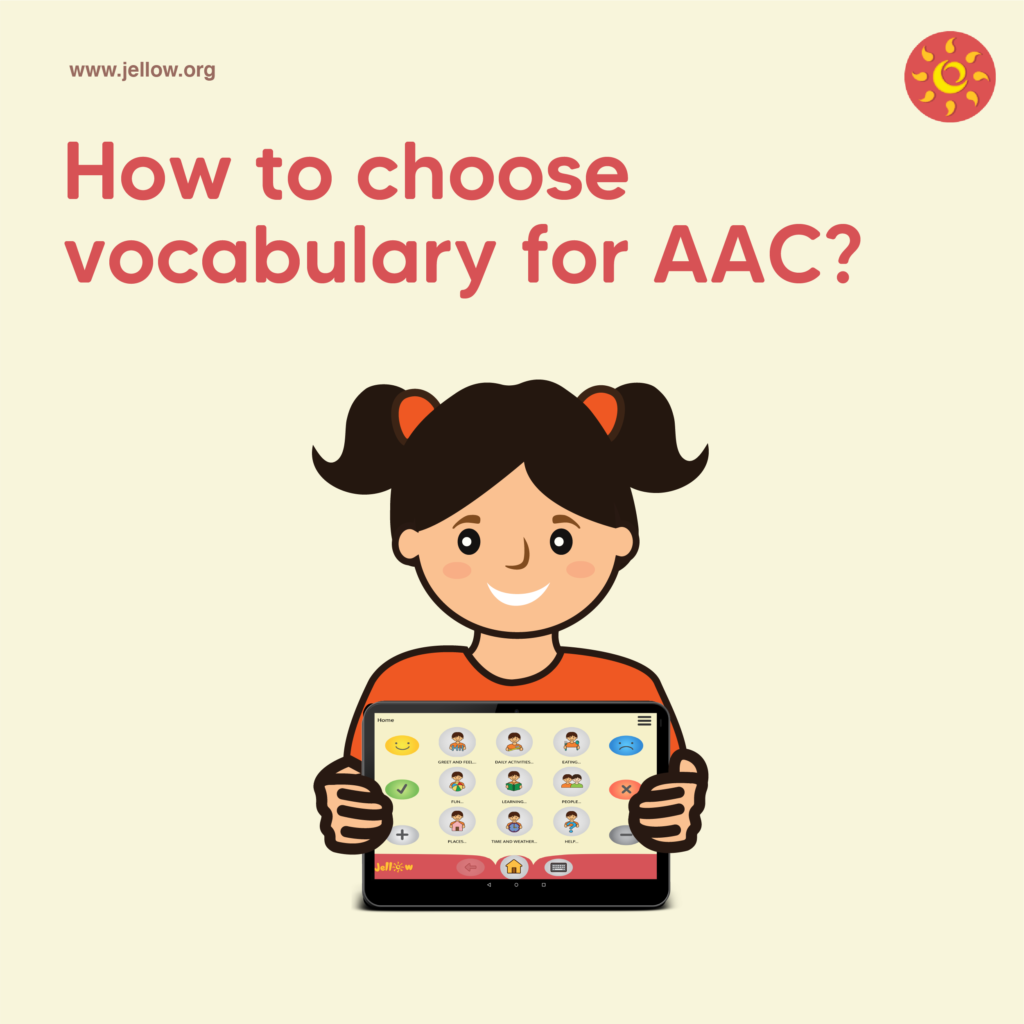
Is your child a new AAC (Augmentative Alternative and Communication) user? Are you unsure of how to start using your child’s AAC? If you have answered ‘Yes’ to any of these questions then you have come to the right place. When you start using an AAC device, there is a list of things that you would need to be aware of. Choosing vocabulary is just one of them. It can be a challenging task especially if you are new to AAC for Children with Autism.
Why is choosing vocabulary important?
- Promotes and motivates communication
- Improves communication with family members and communication partners
- Improves communication in relevant social contexts such as school, home etc.
- Helps use the vocabulary most specific to the individual w.r.t age and culture
- Improves writing, listening and reading skills
- Increases the AAC acceptance and use
In this blog, you will learn how to choose vocabulary for your child’s AAC device.
- Consider your child’s present level
When selecting words, you must always remember to consider your child’s present language levels. Select words as per their receptive and expressive language ages. Also, remember to keep in mind the developmental norms while selecting the vocabulary for AAC. Your speech therapist would be the best to guide you with this.
2. Start off by selecting a few words
Choose words that your child is aware of. For example, favourite food items (idli, chips, chocolate etc.), favourite toys (ball, doll, blocks etc.) etc. These types of words act as ‘communication motivators’. They motivate your child to explore and use AAC (Augmentative and Alternative Communication).
3. Consider your child’s interests
Choose words that your child is interested in. For example, if your child loves playing with trains. Choose words such as train, fast, slow, red, go etc. When you choose words of your child’s interests and use them with AAC, it motivates them to communicate about it.
4. Use different word categories
Language is an amalgam of different word categories. We use verbs, nouns, adjectives, prepositions, conjunctions etc. when we communicate verbally. The same holds true for AAC users. When choosing vocabulary, make sure to use words from all word categories. Consider the developmental norms. According to research, when you use a wide range of word categories, it helps your child communicate more effectively. It would also help them form two-word phrases in the future.
Read this to learn some tips to implement AAC at home.
5. Use a balanced vocabulary
A balanced vocabulary includes core words, fringe words and alphabets.
- Core vocabulary-These include all the word categories (verbs, nouns, adjectives, prepositions, conjunctions etc.) except for nouns. These are words that you can use in a variety of settings. For example verb-‘drink’: “I drink juice”, “The drink is very cold”, “We drink milk in the morning” etc. Our speech is comprised of almost 80% of core words. This makes core words crucial for your child to use. You must use core word vocabulary for AAC.
- Fringe vocabulary- These are the nouns that we use (names, places, animals, fruits etc.). We use nouns in our speech almost 20% of the time. These are low-frequency words. Use fringe words that are very specific to your child’s needs. For example favourite foods, fruits, familiar family members etc.
6. Select words that are motivating and meaningful
- Activity-based vocabulary: If your child loves a specific activity such as ‘building blocks, you can do the activity together and use words such as “Look at the blocks”, “I have a red block”, or “Now let’s make something with these blocks. The word used here is both motivating and meaningful to your child. Make sure to use activity-based vocabulary like this.
- Situation-based vocabulary: Use various situations that your child is familiar with. If your child has set routines like meal times, play times, bath time etc., use these situations to choose appropriate vocabulary. Use this vocabulary when you are doing a specific routine.
- Communication-based vocabulary: Use vocabulary for specific communication functions. This promotes meaningful communication. Some examples of communication functions are greeting, protesting, requesting etc. In this case, you can use vocabulary like ‘hello, bye, no, please, thank you etc.’
- Add new words based your child learns
7. As your child learns their vocabulary, keep adding new words to their AAC device. This will help them to expand their vocabulary and start using phrases and sentences.
Consult with specialists at 1SpecialPlace to get started with AAC. Remember to always seek held from a qualified Speech Language Pathologist for your AAC-related queries. Here are some tips for speech therapy with non-verbal/ non-speaking children.